All products featured are independently chosen by us. However, SoundGuys may receive a commission on orders placed through its retail links. See our ethics statement.
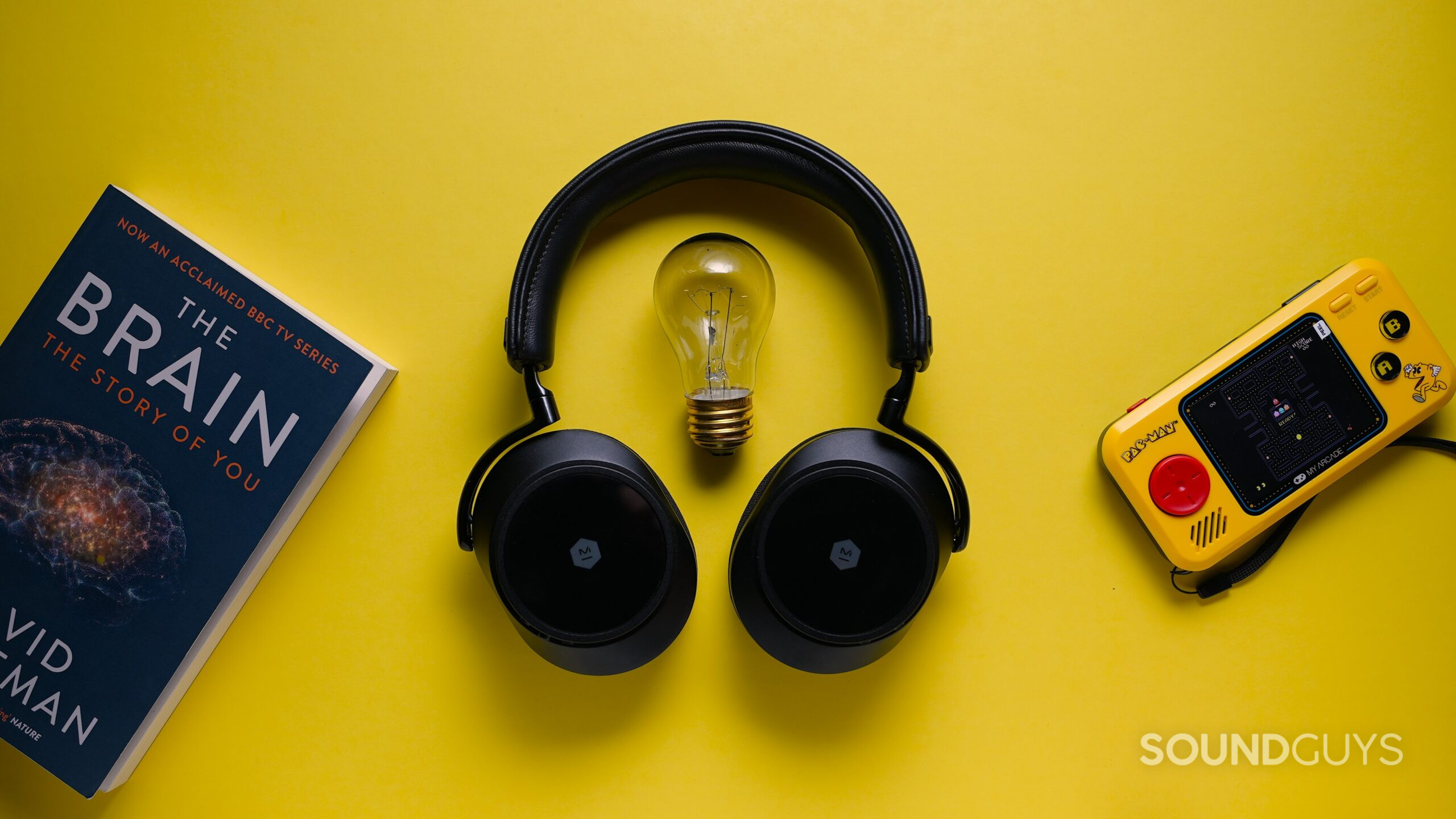
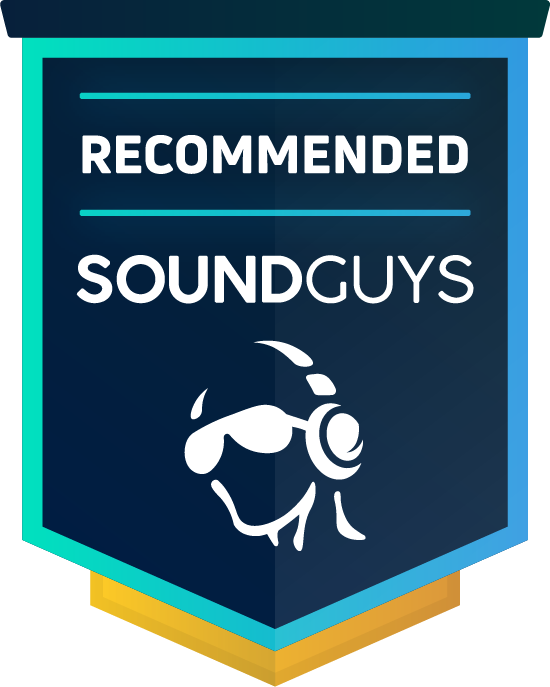
MW75 Neuro review: Headphones that can read your mind
November 8, 2024


MW75 Neuro
When I attended CES at the beginning of this year, one product demo stood out more than others. Now, it’s no longer a prototype and finally on my head. The MW75 Neuro, made in partnership between Master & Dynamic and Neurable AI, represents a new frontier for tech in the form of mental-health tracking via specialized earcups that act as EEG sensors to monitor brain activity, particularly your focus levels. Just as many of us wear smart watches that monitor our biometrics, the MW75 are the first smart headphones that can monitor attention and tell you when your brain needs a break before you feel tired.
I tested the MW75 Neuro for a few days to see if they could actually increase my productivity, as promised. Aside from the advanced brain-tracking features, we also put the MW75 through our audio testing lab to see if these headphones nail the basics. Find out in our MW75 Neuro review.
Editor’s note: this article was updated on November 8, 2024, to include our video review of the MW75 Neuro.
The MW75 Neuro is for those who want to be at the forefront of mental health tracking with the first and currently only Smart EEG headphones. They are for those who want to track their focus levels as easily as we track our daily steps and act on that data to improve their engagement with a specific task, such as studying, reading, or writing.
In the future, this technology might even be able to identify patterns of brain activity consistent with mental health or neurological disorders like ADHD or Alzheimer’s and flag them before they worsen.
What’s it like to use the MW75 Neuro?
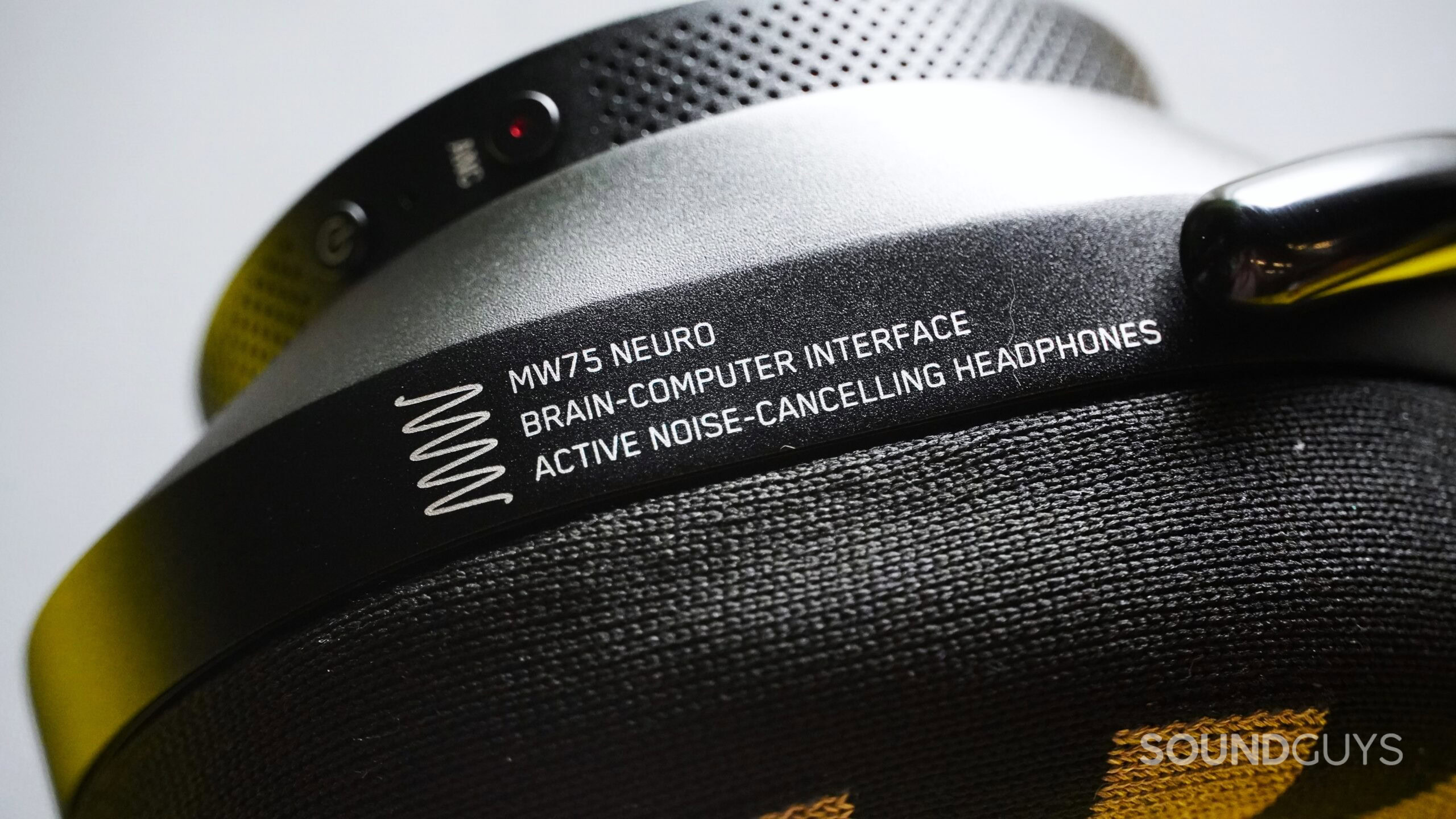
The MW75 Neuro looks almost identical to the standard Master & Dynamic MW75 headphones. As expected from the brand, these headphones are higher-end and made from premium materials. No finicky plastic here. You get a lambskin leather headband and aluminum and tempered glass ear cups. They feel weightier in hand but are comfortable and secure to wear for hours and come with a hardshell travel case to store them. The main difference in design is that instead of leatherskin earpads, the MW75 Neuro gets memory foam earpads, which are also magnetically removable, making them easily replaceable.
The MW75 has simple-to-use physical controls on the back of each earcup. On the left earcup is a power button and an ANC button to toggle the noise cancelation on or off or switch to transparency mode. On the right earcup are buttons to increase or decrease the volume, and between them a play/pause button which you can hold down to activate Siri on iPhone or the Assistant of your choice on Android.
How do the MW75 Neuro headphones work?
The earpads on the MW75 are where all the magic happens. Aside from listening to music, the earpads act as EEG sensors using Neurable’s AI algorithm to scan brain activity, particularly focus levels, in real time. Why? To provide you with data that can help you reach your goals, whether they be creative, work, or school-related.
If you are wondering if this is a pseudoscience that sounds too good to be true, it’s not. At least, not according to the white paper published by the Neurable team. It shows the results of their initial study on EEG sensors in headphones, validating the technology through EEG data collected from 132 participants.
What’s it like to track your brain activity using the MW75 Neuro?
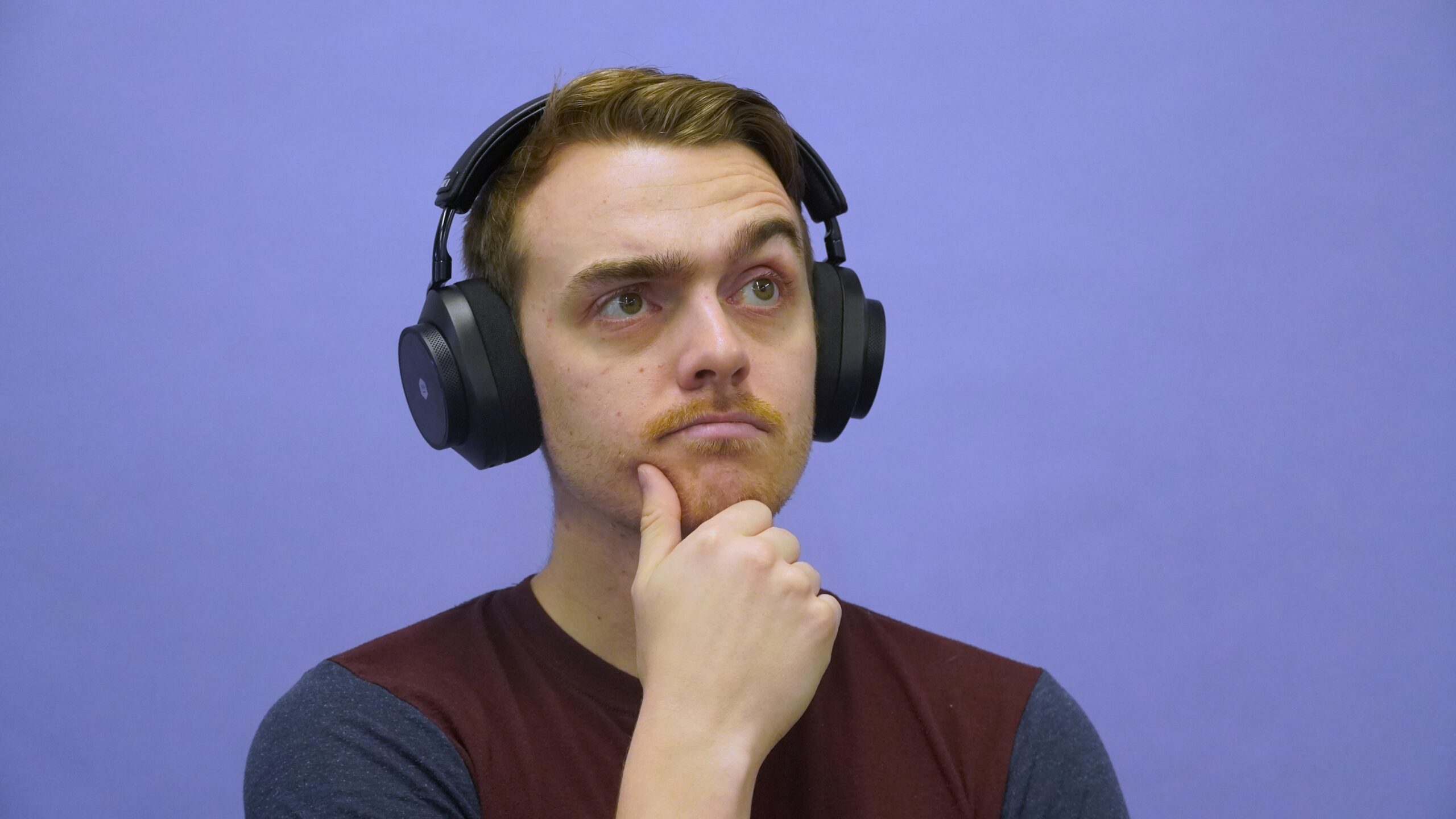
How we feel subjectively about how well we are paying attention can be very different from what is happening objectively. Believe me, I had a bit of a rude awakening when first using the headset. I slipped the headphones on, sat down with a book on brain development, and began reading, thinking to myself within the first few minutes, “Okay, I’m focused; I bet I’m getting good data.” After about 45 minutes, I decided to complete the session and check the results. Turns out, It took about 20 minutes for me to transition from low focus to medium focus, and I didn’t even achieve high-focus once.
Focusing is harder than we think, but the MW75 Neuro can help.
Apparently, it can take the brain about 15-20 minutes to “warm up”, shift gears from whatever you have been doing, and fully focus on a new mental activity. It is possible to minimize this ramping-up time by, say, studying at the same time each day and in the same place, decluttered from distractions. In fact, these are the kinds of insights that the Neurable app started delivering to me after wearing the MW75 Neuro headphones for a couple of days.
Can the MW75 Neuro improve your focus?
Similar to other learning apps, such as Duolingo, the Neurable app is gamified with digital trophies for reaching daily goals and fires for weekly streaks. I found these helped to motivate me a little bit, but at the end of the day, as with learning a language, I find you have to actually want to do it to stick with it, and for me, the data itself was rewarding enough as a new window into my brain I hadn’t looked through before.
Neurable recommends achieving about 100 minutes of high-focus time per day. It doesn’t have to be all at once—you can focus 20 minutes here and 40 minutes there—but each session should be while you are engaged in a single activity. Sometimes, that was hard to achieve wearing the headphones at work as I deal with a lot of moving parts: Slack messages popping up, timely emails to respond to, or the mailman ringing the doorbell to deliver a new audio product for review. In those instances, I could see the peaks and valleys in the data readings where my focus dropped and reclimbed. But I did get some good, uninterrupted workflows in as well, such as sitting down to write this review, which the data validated as a less volatile, steady climb.
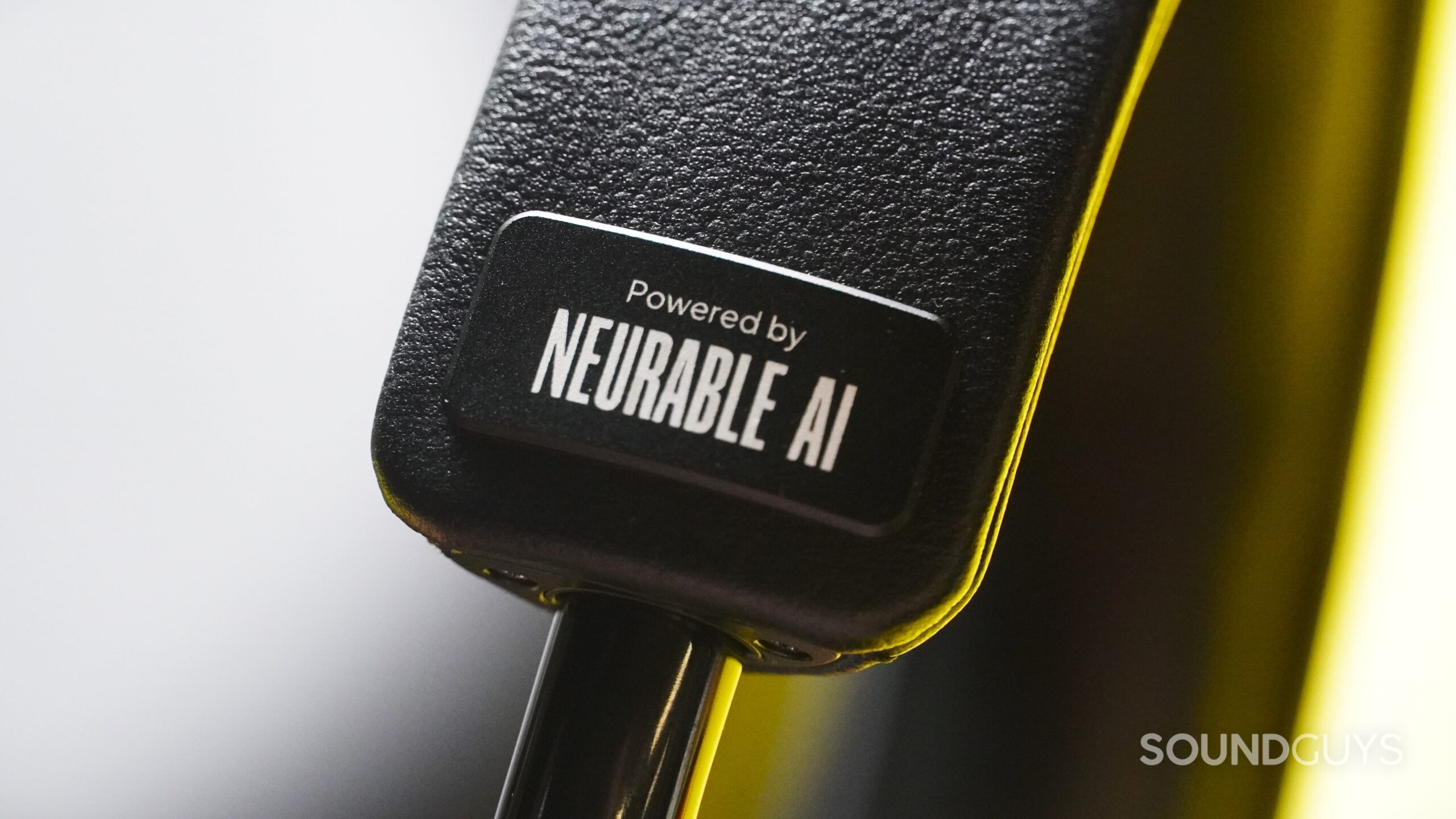
Did this data actually help? Yes, I did see my focus improve after a week of using the Neurbable app. I’ll be honest; I was worried I might never be able to achieve 100 minutes of high focus after the results of my first couple of sessions. But by the fourth or fifth practice, I was able to enter states of medium to high focus quicker and hold them for longer periods of time. The insights helped me discover that mornings and after lunch between 2 and 4 p.m. tended to be the time I was most productive.
The data also helped identify distractions. For instance, whenever I grabbed my phone and started scrolling through some app, my focus levels would drop, so I tried to fight that urge when wearing the headphones. Out of all my recordings, only one session didn’t save due to an “unexpected error,” so the data during that half-hour wasn’t recorded. This might have been a connection issue or one of the kinks they are working out in the app before launch.
Another variable I should note was that I was almost always listening to music with headphones during my focus sessions. I usually listen to something relaxing, like lo-fi hip-hop or jazz, when trying to focus, though some people might prefer silence, and it’s perfectly fine to wear headphones without listening to music with ANC enabled to block out noise. However, one feature I am excited about but wasn’t available during my testing is Spotify integration with the MW75 Neuro. Neurable showed me a demo where the headphones could track which songs and genres are most conducive to the user’s focus based on the data it gathers and would generate playlists over time based on those activities.
The quality and duration of my focus did improve over time.
Some readers might be skeptical of the legitimacy of these data readings. What if the app is just telling me I am getting better, feeding me false feedback to create a placebo effect? While that’s a valid concern, the different data readings I get based on different activities suggest otherwise.
What can you use the MW75 Neuro for?
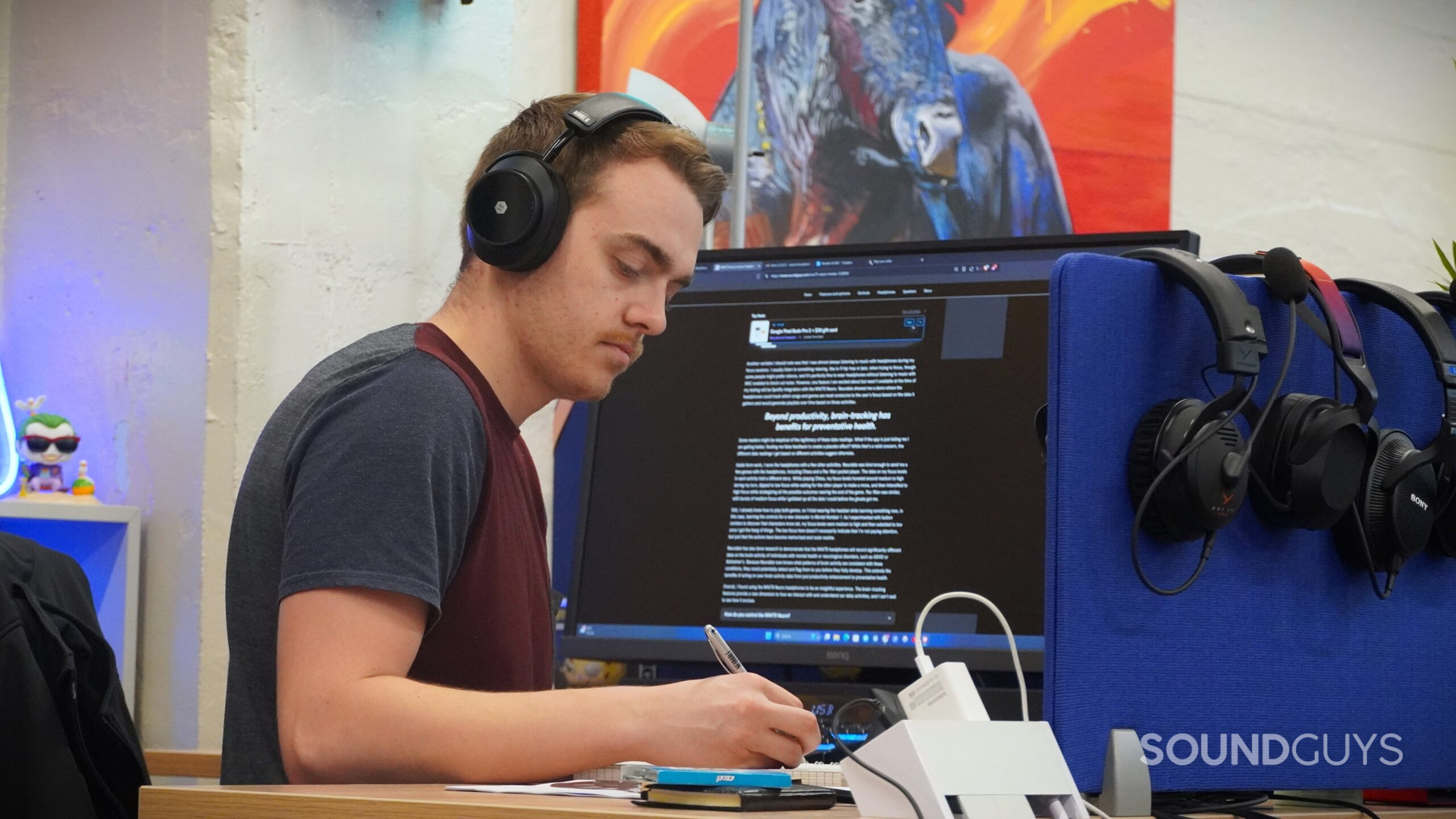
Neurable sent me a few games to try with the headphones, including Chess and a Pac-Man pocket player. The data on my focus levels in each activity told a different story. While playing Chess, my focus levels hovered around medium to high during my turn, dipped to low focus while waiting for the other player to make a move, and then intensified to high focus while strategizing all the possible outcomes nearing the end of the game. Pac-Man was similar, with bursts of medium focus while I gobbled up all the dots I could before the ghosts got me.
Beyond productivity, brain-tracking has benefits for preventative health.
Still, I already knew how to play both games, so I tried wearing the headset while learning something new, in this case, learning the controls for a new character in Mortal Kombat 1. As I experimented with button combos to discover that characters move set, my focus levels were medium to high and then subsided to low once I got the hang of things. The low focus here doesn’t necessarily indicate that I’m not paying attention, but just that the actions have become memorized and route routine.
Neurable has also done research to demonstrate that the MW75 headphones will record significantly different data on the brain activity of individuals with mental health or neurological disorders, such as ADHD or Alzheimer’s. Because Neurable now knows what patterns of brain activity are consistent with these conditions, they could potentially detect and flag them to you before they fully develop. This extends the benefits of acting on your brain activity data from just productivity enhancement to preventative health.
Overall, I found using the MW75 Neuro headphones to be an insightful experience. The brain-tracking features provide a new dimension to how we interact with and understand our daily activities, and I can’t wait to see how it evolves.
How do the MW75 Neuro connect?
The MW75 uses Bluetooth 5.2 with support for AAC and SBC, as well as Snapdragon Sound, which enables aptX Adaptive. The headphones also support Bluetooth Multipoint to connect to two devices simultaneously.
The MW75 Neuro comes with a USB-C to 3.5mm cable for wired listening, as well as a USB-C to USB-A adapter, a 3.5mm to 1/4 adapter, and a flight adapter, so you have plenty of options to plug in wherever you are. Despite all these wired options, however, it’s important to note that you cannot use any of the brain-tracking features with a wired connection, since the headphones must be connected to the Neurable app on your mobile device to do so.
The MW75 Neuro also has on-ear detection, which automatically pauses playback when removed from your head and plays again when you put it on. It will also simultaneously and automatically pause and resume your focus sessions in the Neurable app.
Pairing the MW75 Neuro is as simple as turning them on. The first time you power on your headphones, they will be in pairing mode.
- Press the power button once to turn the MW75 On.
- Open the Bluetooth menu on your device.
- Select MW75 Neuro.
To manually activate pairing mode, hold the Power button for 4 seconds. This can be done when the headphones are on or off. Hold again to cancel pairing mode.
How long does the MW75 Neuro battery last?
Battery life will vary depending on how you use the MW75 Neuro. The company claims the headphones can last 10 hours of EEG recording, 28 hours with ANC on, and up to 32 hours with ANC off. In our standardized testing, the headphones lived up to the later claims, though we weren’t able to test the battery with EEG-enabled in our lab as the sensors need an actual head with a brain to detect, not a testing head. In my daily usage, I would often want to have ANC enabled to help me zone in and focus, and of course, running at the same time as the EEG sensors will drain the battery faster, so you could expect less than 10 hours in such use cases.
The MW75 Neuro does not specify fast charging, but we found it can reach 50% battery life in 40 minutes of charge time.
How well do the MW75 Neuro cancel noise?
Loading chart ...
The MW75 Neuro cancels noise fairly well, reducing the perceived loudness of external noise by an average of 74%. That’s not bad at all, but still not quite as good as the best noise canceling headphones. With ANC on, the MW75 Neuro attenuates low frequencies by up to 20dB and high frequencies by up to 40dB.
The MW75 Neuro do not block out as much noise as the standard MW75 headphones since the MW75 Neuro uses fabric memory foam earpads for its special EEG sensors, while the standard MW75 use leather ear pads, which create a stronger seal around your ears for better isolation. As you can see when comparing to the chart below, the MW75 passively isolates against frequencies above 200Hz, while the MW75 Neuro only isolates against frequencies above 400Hz.
Loading chart ...
The MW75 Neuro has an ambient listening mode, which is fairly good if you want to hear the world around you without removing your headphones. I didn’t notice a huge difference between ambient listening and simply turning ANC off, but my coworkers were a little easier to hear in conversation, and I could pick up more noise from further away across the room.
How do the MW75 Neuro sound?
The MW75 have a bright sound profile with excessive treble and some weak sub-bass that might not appeal to everyone.
Multi-Dimensional Audio Quality Scores (MDAQS)
The chart below shows how the sound of the MW75 Neuro was assessed by the Multi-Dimensional Audio Quality Score (MDAQS) algorithm from HEAD acoustics.
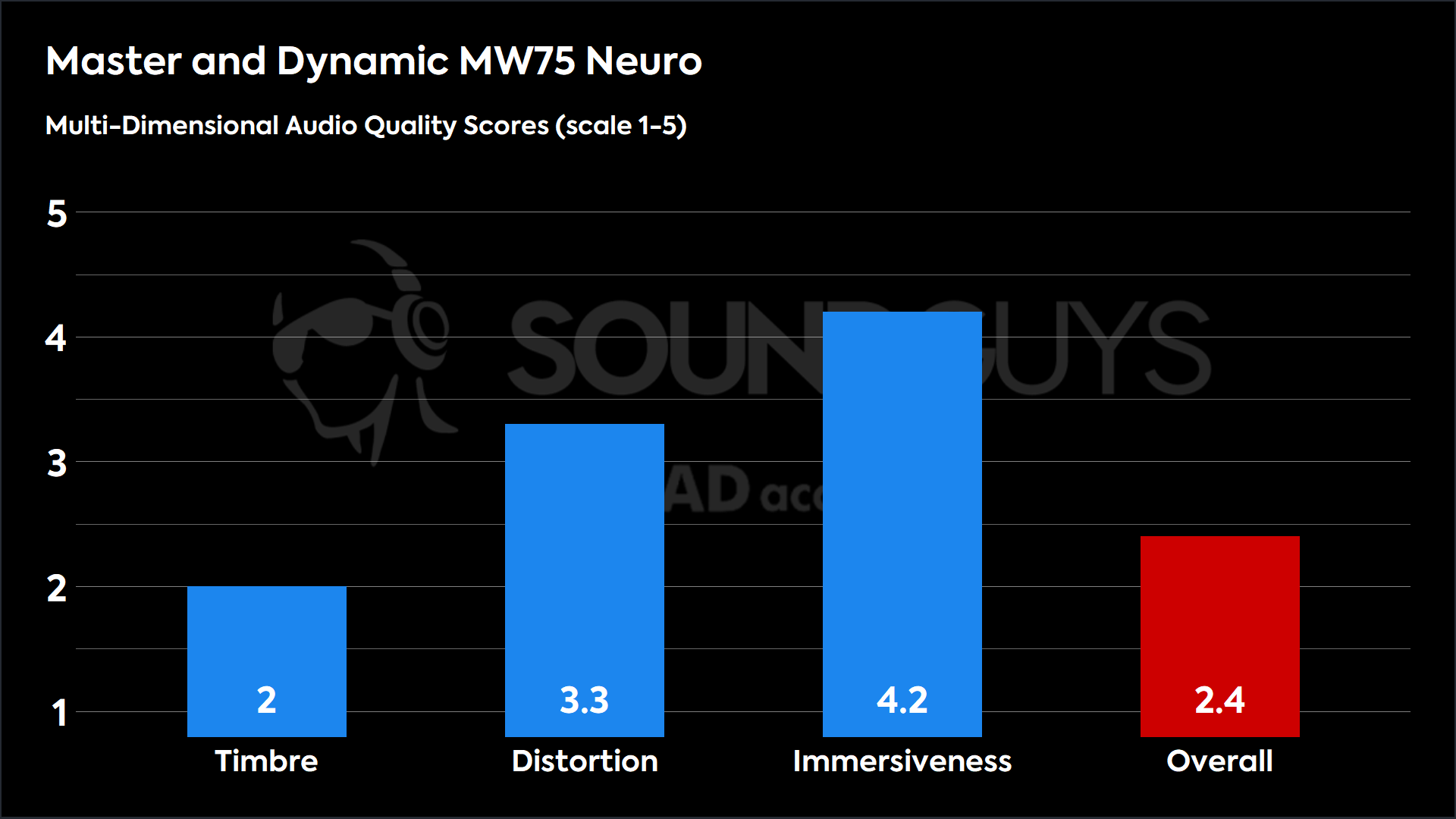
The simulated panel of listeners, as represented by MDAQS, does not give the MW75 Neuro a passing grade. The overall score is mainly brought down by the low score for Timbre, which corresponds to how accurately the frequency spectrum is reproduced. I’ll have more on that later in the objective measurements sub-section, but in short, there are several peaks and dips in the mid-range, which lead to unnatural reproduction of vocals and instruments. On the plus side, there isn’t much distortion, and most people will find the sound immersive.
- Timbre (MOS-T) represents how faithfully the headphones reproduce the frequency spectrum and temporal resolution (timing information).
- Distortion (MOS-D) represents non-linearities and added noise: higher scores mean cleaner reproduction.
- Immersiveness (MOS-I) represents perceived source width and positioning: how well virtual sound sources are defined in three-dimensional space.
See here for an explanation of MDAQS, how it works, and how it was developed.
Reviewer’s notes
Editor’s note: this review uses a hover-enabled glossary to describe sound quality based on a consensus vocabulary. You can read about it here.
Objective Measurements
Loading chart ...
Compared to our industry-validated house curve (pink), the MW75 Neuro (blue) have a frequency response with a few notable deviations. For starters, there is less emphasis in the sub-bass region, even compared to the frequency response of the standard MW75 (yellow). As with the isolation, this is likely due to the difference in earpad material, with the fabric earpads unable to keep low-frequencies in as well.
There’s also a noticeable dip around 4 kHz, which can help reduce fatigue brought on by the high peak at 7Khz, which can bring out some perceived clarity but risks introducing sibilance (overly emphasized ‘s’ and ‘t’ sounds) and making cymbals and hi-hats overly prominent.
Can you use the MW75 Neuro for phone calls?
The MW75 Neuro is perfectly suitable for phone calls in quiet conditions but it does struggle with noise rejection if there are loud noises around you.
MW75 Neuro microphone demo (Ideal conditions):
How does the microphone sound to you?
MW75 Neuro microphone demo (Office conditions):
MW75 Neuro microphone demo (Street conditions):
MW75 Neuro microphone demo (Windy conditions):
MW75 Neuro microphone demo (Reverberant space):
As you can hear in the recording samples above, background noise will come through quite irritably on the microphone. The loud ringing and whirring in the office conditions overpower the speaker’s voice and are hard to ignore. Street and windy conditions outdoors are a little better, but voices can sound muffled.
Should you buy the MW75 Neuro?
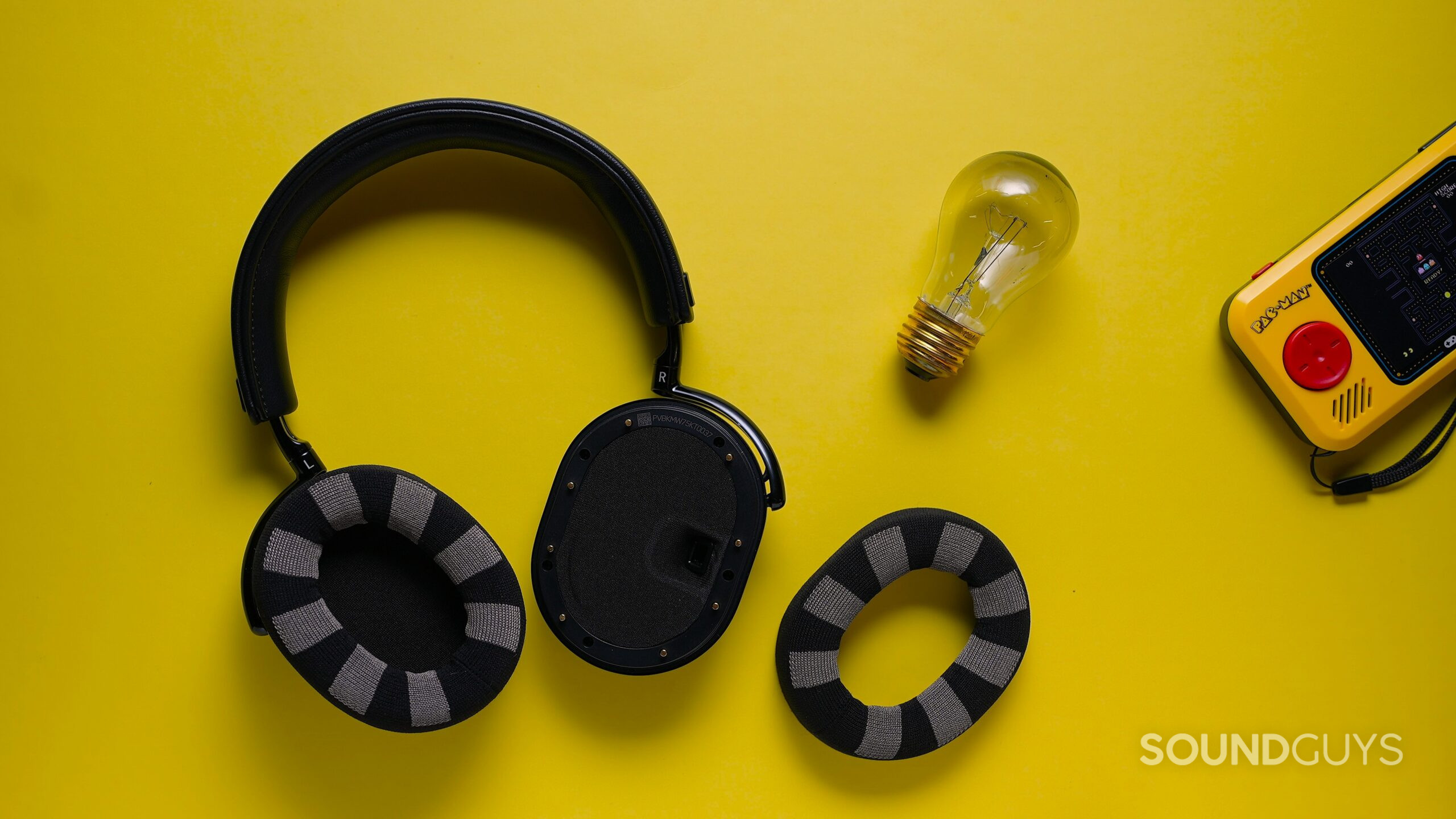
The MW75 Neuro is undoubtedly a premium product, both in terms of its audio capabilities and its cutting-edge brain-tracking technology. For early adopters and those deeply interested in quantifying and improving their cognitive performance, these headphones offer a fascinating toolset. The insights provided by the Neurable app can be genuinely useful for understanding your focus patterns and enhancing productivity.
However, the high price point puts these headphones squarely in the luxury category. While the build quality and features justify much of the cost, it’s a significant investment that may be hard to swallow for many consumers. Additionally, the default sound profile, with its bright signature and less-than-average MDAQS results, will likely not appeal to everyone.
I hope to see Neurable's brain-tracking technology make it's way to other headphones.
For those who are curious about brain-tracking technology but not quite ready to dive in, it might be worth waiting to see if Neurable AI brings this feature to more affordable headsets in the future. I am excited by the prospect of widespread access to brain-tracking technology, and it would be great to see this become more accessible to a broader audience.
Ultimately, the MW75 Neuro is a niche product for now — a high-quality pair of headphones with a forward-thinking feature set. If you’re fascinated by the intersection of neurotechnology and audio, and you have the budget to support your interest, these headphones offer a unique and valuable experience. For others, it might be worth keeping an eye on how this technology develops and becomes more mainstream in the coming years.

Our review of Master & Dynamic MW product launches reveals a pattern of frequent updates, often with about 1-2 years between core models. Recent launches include the MW09 in 2023 , MW75 in early 2024 , and MW75 Neuro in late 2024 . This continues a trend of new product introductions or notable refreshes within the family each year, shifting between headphone and earbud releases. Given the ongoing innovation and consistent annual activity, especially following two MW75 variations released within a short span, we anticipate Master & Dynamic will likely announce the next MW-series model in 2025. While the exact quarter can vary, our expert insights suggest Master & Dynamic maintains an active update cadence and users can expect a new addition to this family within the current year.
What should you get instead of the MW75 Neuro?
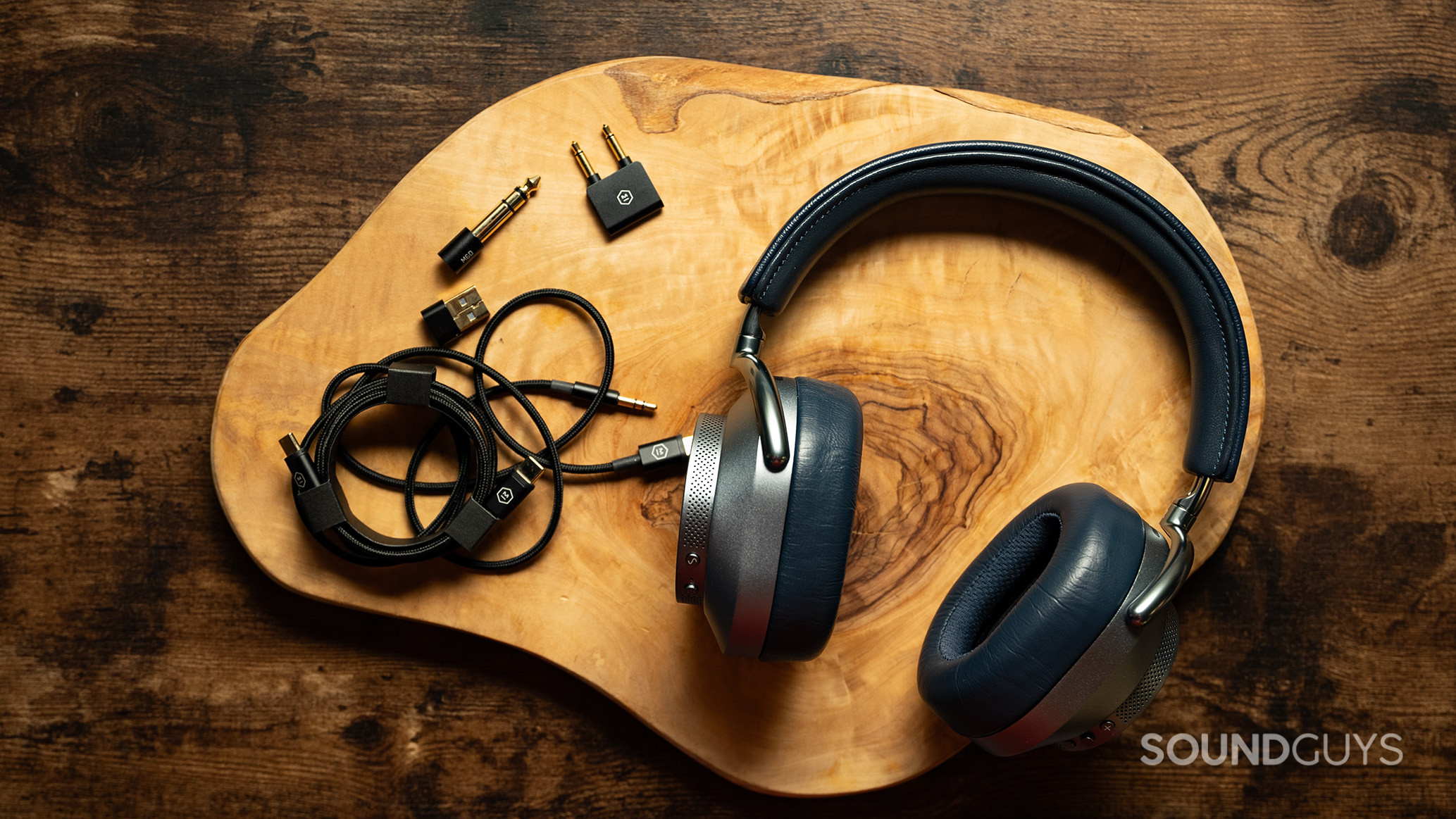
As of now, no other headphones on the market offer brain-tracking capabilities similar to the MW75 Neuro. If this feature draws you to these headphones, you’ll have to either invest in the MW75 Neuro or wait to see if this technology becomes available in other products in the future. Given the innovative nature of this feature, it’s possible we’ll see it integrated into other headphones or even more affordable options down the line.
If you want similar audio quality without brain-tracking, consider the standard Master & Dynamic MW75 headphones. These offer the same premium build quality and similar audio performance but with better isolation and improved bass response due to leather earpads instead of the fabric ones used in the Neuro version. They are also more affordable at $599 at Manufacturer site.
If you’re looking for high-end headphones in general, there are several options in the premium headphone market that offer outstanding audio quality, noise cancellation, and features. Some top contenders include the Sony WH-1000XM5, the Bose QuietComfort Ultra if you have a newer Android phone, the Apple AirPods Max if you have an iPhone, or the Sennheiser Momentum 4 Wireless if you want great battery life.
Frequently asked questions
No.
Yes.
The MW75 Neuro could be okay for light exercise, but they don’t have the most secure fit and will move around if you shake your head. They are also not waterproof, so you won’t want to sweat in them a lot. Still, the earpads are washable (just not in a machine), and you might want to track your focus while working out.
Yes, the MW75 Neuro can be used wired, but the brain-wave tracking features only work wirelessly when connected to the Neurable app.
Yes, the MW75 Neuro works with iPhone and Android, and you can download the Neurable app on either device.
Thank you for being part of our community. Read our Comment Policy before posting.